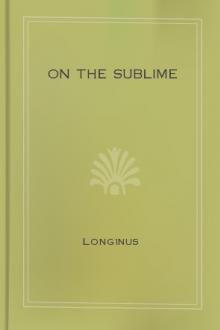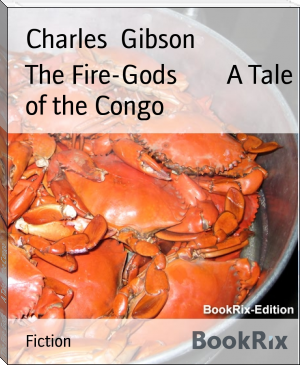On the Sublime by active 1st century Longinus (people reading books .txt) 📖

- Author: active 1st century Longinus
- Performer: -
Book online «On the Sublime by active 1st century Longinus (people reading books .txt) 📖». Author active 1st century Longinus
Who makes my heart to ache shall rue the day!”50
But there is nothing grand in the mere employment of an oath. Its grandeur will depend on its being employed in the right place and the right manner, on the right occasion, and with the right motive. In Eupolis the oath is nothing beyond an oath; and the Athenians to whom it is addressed are still prosperous, and in need of no consolation. Moreover, the poet does not, like Demosthenes, swear by the departed heroes as deities, so as to engender in his audience a just conception of their valour, but diverges from the champions to the battle—a mere lifeless thing. But Demosthenes has so skilfully managed the oath that in addressing his countrymen after the defeat of Chaeronea he takes out of their minds all sense of disaster; and at the same time, while proving that no mistake has been made, he holds up an example, confirms his arguments by an oath, and makes his praise of the dead an incentive to the living. 4 And to rebut a possible objection which occurred to him—“Can you, Demosthenes, whose policy ended in defeat, swear by a victory?”—the orator proceeds to measure his language, choosing his very words so as to give no handle to opponents, thus showing us that even in our most inspired moments reason ought to hold the reins.51 Let us mark his words: “Those who faced the foe at Marathon; those who fought in the sea-fights of Salamis and Artemisium; those who stood in the ranks at Plataea.” Note that he nowhere says “those who conquered,” artfully suppressing any word which might hint at the successful issue of those battles, which would have spoilt the parallel with Chaeronea. And for the same reason he steals a march on his audience, adding immediately: “All of whom, Aeschines,—not those who were successful only,—were buried by the state at the public expense.”
XVIIThere is one truth which my studies have led me to observe, which perhaps it would be worth while to set down briefly here. It is this, that by a natural law the Sublime, besides receiving an acquisition of strength from figures, in its turn lends support in a remarkable manner to them. To explain: the use of figures has a peculiar tendency to rouse a suspicion of dishonesty, and to create an impression of treachery, scheming, and false reasoning; especially if the person addressed be a judge, who is master of the situation, and still more in the case of a despot, a king, a military potentate, or any of those who sit in high places.52 If a man feels that this artful speaker is treating him like a silly boy and trying to throw dust in his eyes, he at once grows irritated, and thinking that such false reasoning implies a contempt of his understanding, he perhaps flies into a rage and will not hear another word; or even if he masters his resentment, still he is utterly indisposed to yield to the persuasive power of eloquence. Hence it follows that a figure is then most effectual when it appears in disguise. 2 To allay, then, this distrust which attaches to the use of figures we must call in the powerful aid of sublimity and passion. For art, once associated with these great allies, will be overshadowed by their grandeur and beauty, and pass beyond the reach of all suspicion. To prove this I need only refer to the passage already quoted: “I swear it by the men,” etc. It is the very brilliancy of the orator’s figure which blinds us to the fact that it is a figure. For as the fainter lustre of the stars is put out of sight by the all-encompassing rays of the sun, so when sublimity sheds its light all round the sophistries of rhetoric they become invisible. 3 A similar illusion is produced by the painter’s art. When light and shadow are represented in colour, though they lie on the same surface side by side, it is the light which meets the eye first, and appears not only more conspicuous but also much nearer. In the same manner passion and grandeur of language, lying nearer to our souls by reason both of a certain natural affinity and of their radiance, always strike our mental eye before we become conscious of the figure, throwing its artificial character into the shade and hiding it as it were in a veil.
XVIIIThe figures of question and interrogation53 also possess a specific quality which tends strongly to stir an audience and give energy to the speaker’s words. “Or tell me, do you want to run about asking one another, is there any news? what greater news could you have than that a man of Macedon is making himself master of Hellas? Is Philip dead? Not he. However, he is ill. But what is that to you? Even if anything happens to him you will soon raise up another Philip.”54 Or this passage: “Shall we sail against Macedon? And where, asks one, shall we effect a landing? The war itself will show us where Philip’s weak places lie.”54 Now if this had been put baldly it would have lost greatly in force. As we see it, it is full of the quick alternation of question and answer. The orator replies to himself as though he were meeting another man’s objections. And this figure not only raises the tone of his words but makes them more convincing. 2 For an exhibition of feeling has then most effect on an audience when it appears to flow naturally from the occasion, not to have been laboured by the art of the speaker; and this device of questioning and replying to himself reproduces the moment of passion. For as a sudden question addressed to an individual will sometimes startle him into a reply which is an unguarded expression of his genuine sentiments, so the figure of question and interrogation blinds the judgment of an audience, and deceives them into a belief that what is really the result of labour in every detail has been struck out of the speaker by the inspiration of the moment.
There is one passage in Herodotus which is generally credited with extraordinary sublimity....
XIX... The removal of connecting particles gives a quick rush and “torrent rapture” to a passage, the writer appearing to be actually almost left behind by his own words. There is an example in Xenophon: “Clashing their shields together they pushed, they fought, they slew, they fell.”55 And the words of Eurylochus in the Odyssey—
We found a stately hall built in a mountain glade.”56
Words thus severed from one another without the intervention of stops give a lively impression of one who through distress of mind at once halts and hurries in his speech. And this is what Homer has expressed by using the figure Asyndeton.
XXBut nothing is so conducive to energy as a combination of different figures, when two or three uniting their resources mutually contribute to the vigour, the cogency, and the beauty of a speech. So Demosthenes in his speech against Meidias repeats the same words and breaks up his sentences in one lively descriptive passage: “He who receives a blow is hurt in many ways which he could not even describe to another, by gesture, by look, by tone.” 2 Then, to vary the movement of his speech, and prevent it from standing still (for stillness produces rest, but passion requires a certain disorder of language, imitating the agitation and commotion of the soul), he at once dashes off in another direction, breaking up his words again, and repeating them in a different form, “by gesture, by look, by tone—when insult, when hatred, is added to violence, when he is struck with the fist, when he is struck as a slave!” By such means the orator imitates the action of Meidias, dealing blow upon blow on the minds of his judges. Immediately after like a hurricane he makes a fresh attack: “When he is struck with the fist, when he is struck in the face; this is what moves, this is what maddens a man, unless he is inured to outrage; no one could describe all this so as to bring home to his hearers its bitterness.”57 You see how he preserves, by continual variation, the intrinsic force of these repetitions and broken clauses, so that his order seems irregular, and conversely his irregularity acquires a certain measure of order.
XXISupposing we add the conjunctions, after the practice of Isocrates and his school: “Moreover, I must not omit to mention that he who strikes a blow may hurt in many ways, in the first place by gesture, in the second place by look, in the third and last place by his tone.” If you compare the words thus set down in logical sequence with the expressions of the “Meidias,” you will see that the rapidity and rugged abruptness of passion, when all is made regular by connecting links, will be smoothed away, and the whole point and fire of the passage will at once disappear. 2 For as, if you were to bind two runners together, they will forthwith be deprived of all liberty of movement, even so passion rebels against the trammels of conjunctions and other particles, because they curb its free rush and destroy the impression of mechanical impulse.
XXIIThe figure hyperbaton belongs to the same class. By hyperbaton we mean a transposition of words or thoughts from their usual order, bearing unmistakably the characteristic stamp of violent mental agitation. In real life we often see a man under the influence of rage, or fear, or indignation, or beside himself with jealousy, or with some other out of the interminable list of human passions, begin a sentence, and then swerve aside into some inconsequent parenthesis, and then again double back to his original statement, being borne with quick turns by his distress, as though by a shifting wind, now this way, now that, and playing a thousand capricious variations on his words, his thoughts, and the natural order of his discourse. Now the figure hyperbaton is the means which is employed by the best writers to imitate these signs of natural emotion. For art is then perfect when it seems to be nature, and nature, again, is most





Comments (0)